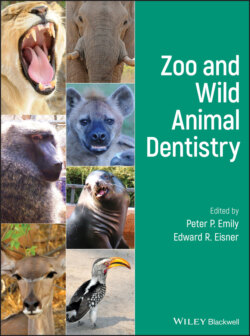Читать книгу Zoo and Wild Animal Dentistry - Группа авторов - Страница 17
2 Odontology : A History of Teeth
ОглавлениеPeter P. Emily
Lakewood, CO, USA
The history of teeth mirrors the evolution of the world. As environmental changes occurred, teeth needed to adapt for survival. Except for fossilized contents, teeth were the best clue to the diets that changed dentition over time.
Primate and human dental evolution were nearly as varied as the evolution of carnivores and herbivores. Following, is some of the many evolutionary concepts of herbivore and carnivore evolution. The various theories on dental evolution hold that teeth evolved from scales of dermal denticles. Oskar Hertwig showed that skin denticles and teeth are homologous – skin denticles being very similar to tricuspid secodont teeth. Evidence of the ascending Paleozoic fish and reptiles show dermal plates throughout the palate that led to a primitive dental function. The mouth of Pelycosaur Edaphosaurus is an example of palatal nodules. The area of the mouth covered in teeth was greatest among these ancient reptiles. They were an adaptation for eating hard‐shelled prey, as seen in the Placodonts from the later Triassic period (see Figure 2.1).
As teeth became more specialized, the fixation to the jaws by bony attachment evolved. In particular, Pleurodont, Acrodont, Thecodont, and Prothecodont dentition evolved. These forms of attachment still remain to the present day.
In the long Carboniferous period, adaptation to land evolved among the oldest reptiles, the synapsid Pleosaurs. The Transition from gill‐breathing to lung‐breathing tetrapods took place toward the end of the Devonian period, 200 plus million years BCE. Therapsids bridged the chasm between the reptiles and primitive mammals. Therapsidia had several families that were partially herbivorous and partially carnivorous. Dicynodon had only one single tooth on each side of the maxilla. Some were toothless herbivores. A second subgroup of therapsids was composed of theridonts and cynodonts. They were possibly the first to show mammal‐like heterodontous dentition.
Figure 2.1 Pelycosaur Edaphosaurus.
Source: A.S. Romer [1].
The Pelycosaurs showed the beginnings of a segregation of the dentition into pre‐canine and post‐canine tooth series. Later, advanced synapsids possessed differentiation of tooth form in different regions of their dentition. In the late Triassic period, some forms of reptiles such as Ictidosauria, had mammal‐like teeth, yet belonged to a class of reptiles.
Pelycosaurs show clear evidence of heterodonty in some species with numerous teeth of equal size but with two larger anterior maxillary teeth, which points to the possible beginning of canine teeth. Dimetrodon and Edaphosaurus both possessed similar body structure but their mode of life differed appreciably since according to their dentition, Edaphosaurus was an herbivore, and Dimetrodon a predacious carnivore (see Figures 2.2– 2.4 ).
